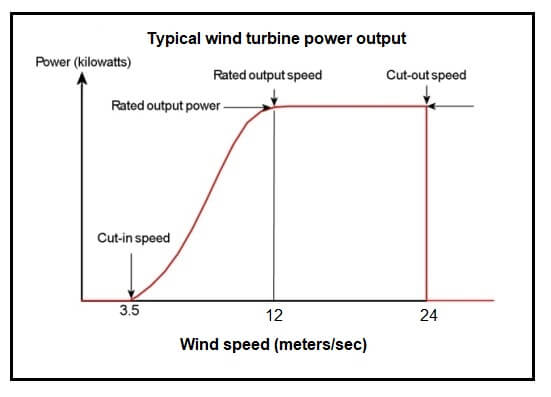With Hurricane Irma heading for Florida, you’ll be forgiven for letting Hurricane Harvey recede into memory. Let me refresh: Like an angry drunk, Harvey stumbled around Texas pushing things over with high winds and monsoon-like rain. Wind speeds of 130 mph were forecasted.
If you’re a wind industry advocate, as soon as you hear talk of wind speeds, you think wind turbines. While Texas wind farms near the coast probably shut down during the storm, suppose a turbine could tolerate hurricane-high winds and produce power accordingly. In this math experiment let’s estimate how much power a 5-MW turbine might produce if its mechanical and electrical systems could hold together.

The power versus wind speed graph for a typical utility-scale wind turbine shows the power output necessarily limited so the machine does not destroy itself. But if it were possible to capture energy above 12 m/sec, impressive outputs would be possible.
Examine the power curve for a 5-MW turbine (actually most utility scale turbines) and you’ll find that power generation commences about 3.5 m/sec, levels off about 12 m/sec, and shuts down around 24 m/s. Our imaginary system will keep on working beyond 5 MW.
Let’s start with the equation for kinetic energy, the maximum energy in the wind:
Ke = ½ mv2
and rewrite it this way:
Ke = cv2
Here, c is a sort of production constant that includes ½m and other turbine-specific things such as blade aerodynamics along with mechanical and electrical peculiarities.
Solving for c gives:
c = Ke/v2
For our 5 MW or 5,000-kW turbine:
c = 5,000 kW / (12 m/sec)2
= 34.7 kW sec2 / m2
The units are messy but they cancel out later.
Now, what if our turbine could produce power following the trajectory of the power curve beyond 12 m/s and not plateauing there?
At 25 m/sec, just beyond the cut-out speed, our 5-MW turbine could produce:
Ke = cv2
Ke = 34.7 kWsec2 / m2 x (25 m/sec)2
= 21,687 kW or
= 21.7 MW
Pretty impressive, right? That shows how much power the wind contains that is not captured by a 5-MW turbine. However, if I recall correctly, winds beyond 12 m/s happen only about 8% of the time.
Now let’s put SuperTurbine into Harvey’s 100 mph or 44.7 m/s winds to see what is possible.
Ke = 34.7 kWs2 / m2 x (44.7 m/s)2
= 69,333 kW or
= 69.3 MW
From one turbine! Of course, this is just a numbers game. Such an impressive output would be more impressive if it weren’t for limitations imposed by physics and material science.
Just imagine what would you could do with this power during a hurricane, other than accidentally electrocute someone. Maybe pump the suddenly plentiful fresh water out of the flood zone to parched areas of the country? Lake Meade could use a refill.
What would you do with 69 sudden megawatts?
- Paul Dvorak
Filed Under: News, Offshore wind, Turbines




